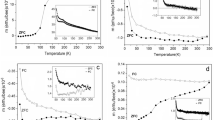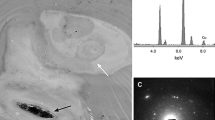Abstract
The detection of the geomagnetic field by animals to use as a cue in homing and migration is known as magnetoreception. The ferromagnetic hypothesis explains magnetoreception assuming that magnetic nanoparticles in cellular structures are used as magnetic field transducers. Considering magnetoreception in social insects, the most studied has been the honeybee Apis mellifera and only in two wasp species (Vespa orientalis and Polybia paulista) have been shown a magnetosensitive behavior. In the present report the body parts (abdomen, head and antennae) of Polistes versicolor and Polybia paulista wasps were studied aiming to find biomineralized magnetic nanoparticles, using magnetometry measurements and ferromagnetic resonance spectroscopy. The magnetometry measurements show the presence of magnetic nanoparticles in all body parts, being characterized as mixtures of superparamagnetic, single domain and pseudo-single domain nanoparticles. From the ferromagnetic resonance spectra were obtained the asymmetry ratio A and the effective g factor geff, and those parameters are consistent with the presence of biomineralized magnetic nanoparticles in both wasps. In the case of Polybia paulista, the magnetic nanoparticles can be associated with some sort of magnetosensor once this wasp is magnetosensitive. For Polistes versicolor, the results indicate that this wasp can be magnetosensitive as Polybia paulista once their magnetic nanoparticles are biomineralized in the body. Behavioral studies with Polistes versicolor wasps deserve to be performed.





Similar content being viewed by others
References
Abraçado LG, Esquivel DMS, Wajnberg E (2012) ZFC/FC of oriented magnetic material in the Solenopsis interrupta head with antennae: characterization by FMR and SQUID. J Biol Phys 38:607–621. https://doi.org/10.1007/s10867-012-9275-7
Acosta-Avalos D, Wajnberg E, Oliveira PS, Leal I, Farina M, Esquivel DM (1999) Isolation of magnetic nanoparticles from Pachycondyla marginata ants. J Exp Biol 202:2687–2692
Amor M, Mathon FP, Monteil CL, Busigny V, Lefevre CT (2020) Iron-biomineralizing organelle in magnetotactic bacteria: function, synthesis and preservation in ancient rock samples. Environ Microbiol 22:3611–3632. https://doi.org/10.1111/1462-2920.15098
Blakemore R (1975) Magnetotactic bacteria. Science 190:377–379. DOI: https://doi.org/10.1126/science.170679
Bohra M, Agarwal N, Singh V (2019) A short review on verwey transition in nanostructured Fe3O4 materials. J Nanomater 2019:8457383. https://doi.org/10.1155/2019/8457383
Brock RE, Cini A, Sumner S (2021) Ecosystem services provided by aculeate wasps. Biol Rev 96:1645–1675. https://doi.org/10.1111/brv.12719
Carbone C, Di Benedetto F, Marescotti P, Sangregorio C, Sorace L, Lima N, Cipriani C (2005) Natural Fe-oxide and-oxyhydroxide nanoparticles: an EPR and SQUID investigation. Mineral Petrol 85:19–32. https://doi.org/10.1007/s00710-005-0098-0
Chambarelli LL, Pinho MA, Abraçado LG, Esquivel DMS, Wajnberg E (2008) Temporal and preparation effects in the magnetic nanoparticles of Apis mellifera body parts. J Magn Magn Mater 320:e207–e210. https://doi.org/10.1016/j.jmmm.2008.02.049
de Oliveira SA, Monteiro de Castro M, Prezoto F (2010) Foundation pattern, productivity and colony success of the paper wasp, Polistes versicolor. J Insect Sci 10:125. Doi: https://doi.org/10.1673/031.010.12501
Dunlop DJ (1973) Superparamagnetic and single-domain threshold sizes in magnetite. J Geophys Res 78:1780–1793. https://doi.org/10.1029/JB078i011p01780
Dunlop DJ, Carter-Stiglitz B (2006) Day plots of mixtures of superparamagnetic, single-domain, pseudosingle-domain, and multidomain magnetites. J Geophys Res 111:B12S09. https://doi.org/10.1029/2006JB004499
Gobbi N (1978) Determinação do raio de voo de operarias de P. versicolor (Hymenoptera, Vespidae). Ciencia e Cultura 30:364–365
Hallett AC, Mitchell RJ, Chamberlain ER, Karron JD (2017) Pollination success following loss of a frequent pollinator: the role of compensatory visitation by other effective pollinators. AoB Plants 9:plx020. https://doi.org/10.1093/aobpla/plx020
Hermes MG, Kohler A (2006) The flower-visiting social wasps (Hymenoptera, Vespidae, Polistinae) in two áreas of Rio Grande do Sul State, Southern Brazil. Rev Bras Entomol 50:268–274. https://doi.org/10.1590/S0085-56262006000200008
Housen BA, Moskowitz BM (2006) Depth distribution of magnetofossils in near-surface sediments from the Blake/Baham outer ridge, western North Atlantic Ocean, determined by low-temperature magnetism. J Geophys Res 111:G01005. https://doi.org/10.1029/2005JG000068
Hsu CY, Ko FY, Li CW, Fann K, Lue JT (2007) Magnetoreception system in honeybees (Apis mellifera). PLoS ONE 2:e395. doi: https://doi.org/10.1371/journal.pone.0000395
Ibusuki T, Kojima S, Kitakami O, Shimada Y (2001) Magnetic anisotropy and behaviors of Fe nanoparticles. IEEE Trans Magn 37:2223–2225. https://doi.org/10.1109/20.951130
Itô Y, Noll FB, Zucchi R (1997) Initial stage of nest construction in a neotropical swarm-founding wasp, Polybia paulista (Hymenoptera: Vespidae). Sociobiology 30:227–235
Jeanne RL (1975) The adaptiveness of social wasp nest architecture. Q Rev Biol 50:267–287. https://doi.org/10.1086/408564
Jeanne RL (1991) Polyethism. In: Ross KG, Matthews RW (eds) The social biology of wasps. Cornell University Press, Ithaca, pp 389–425
Johnsen S, Lohmann KJ (2005) The physics and neurobiology of magnetoreception. Nat Rev Neurosci 6:703–712. https://doi.org/10.1038/nrn1745
Kalmijn A (1981) Biophysics of geomagnetic field detection. IEEE Trans Magn 17:1113–1124. https://doi.org/10.1109/TMAG.1981.1061156
Kisliuk M, Ishay J (1977) Influence of an additional magnetic field on hornet nest architecture. Experientia 33:885–887. https://doi.org/10.1007/BF01951261
Kopp RE, Weiss BP, Maloof AC, Vali H, Nash CZ, Kirschvink JL (2006a) Chains, clumps, and strings: Magnetofossil taphonomy with ferromagnetic resonance spectroscopy. Earth Planet Sci Lett 247:10–25. https://doi.org/10.1016/j.epsl.2006.05.001
Kopp RE, Nash CZ, Kobayashi A, Weiss BP, Bazylinski DA, Kirschvink JL (2006b) Ferromagnetic resonance spectroscopy for assessment of magnetic anisotropy and magnetostatic interactions: a case study of mutant magnetotactic bacteria. J Geophys Res Solid Earth 111:B12S25. https://doi.org/10.1029/2006JB004529
Kudô K (2021) The biology of swarm-founding epiponine wasp, Polybia paulista. In: Prezoto F, Nascimento FS, Correa BR, Somavilla A (eds) Neotropical social: basic and applied aspects. Springer, pp 127–145
Kudô K, Zucchi R, Tsuchida K (2003) Initial nest development in the swarm-founding paper wasp, Polybia paulista (Hymenoptera: Vespidae, Epiponini): cases of building multiple initial combs. J New York Entomol Soc 111:151–158. https://doi.org/10.1664/0028-7199(2003)111[0151:INDITS]2.0.CO;2
Kudô K, Tsujita S, Tsuchida K et al (2005) Stable relatedness structure of the large-colony swarm-founding wasp Polybia paulista. Behav Ecol Sociobiol 58:27–35. https://doi.org/10.1007/s00265-004-0903-5
Lambinet V, Hayden ME, Reigl K, Gomis S, Gries G (2017) Linking magnetite in the abdomen of honey bees to a magnetoreceptive function. Proc R Soc B 284:20162873. https://doi.org/10.1098/rspb.2016.2873
Lucano MJ, Cernicchiaro G, Wajnberg E, Esquivel DMS (2006) Stingless bee antennae: a magnetic sensory organ? BioMetals. 19:295–300. https://doi.org/10.1007/s10534-005-0520-4
Pardoe H, Chua-Anusorn W, Pierre TGS, Dobson J (2001) Structural and magnetic properties of nanoscale iron oxide particles synthesized in the presence of dextran or polyvinyl alcohol. J Magn Magn Mat 225:41–46. https://doi.org/10.1016/S0304-8853(00)01226-9
Peisach J, Blumberg WE, Lode ET, Coon MJ (1971) An analysis of the electron paramagnetic resonance spectrum of pseudomonas oleovorans rubredoxin. A method for determination of the liganids of ferric iron in completely rhombic sites. J Biol Chem 246:5877–5881
Pereira MC, Guimarães IC, Acosta-Avalos D, Antonialli-Junior WF (2019) Can altered magnetic field affect the foraging behaviour of ants? PLoS ONE 14:e0225507. https://doi.org/10.1371/journal.pone.0225507
Pereira MC, Pereira-Bomfim MGC, Guimarães IC, Rodrigues CAP, Serna JP, Acosta-Avalos D, Antonialli-Junior WF (2021) Magnetosensibility and magnetic properties of Ectatomma brunneun Smith, F. 1858 ants. Sociobiology 68:e5188. https://doi.org/10.13102/sociobiology.v68il.5188
Pereira-Bomfim MGC, Antonialli-Junior WF, Acosta-Avalos D (2015) Effect of magnetic field on the foraging rhythm and behavior of the swarm-founding paper wasp Polybia paulista Ihering (Hymenoptera: Vespidae). Sociobiology 61:99–104. https://doi.org/10.13102/sociobiology.v62i1.99-104
Pereira-Bomfim MGC, Antonialli-Junior WF, Acosta-Avalos D (2016) Magnetoreception in social wasps: an update. EntomoBrasilis 9:1–5. doi:https://doi.org/10.12741/ebrasilis.v9i1.526
Prezoto F (2021) Neotropical social wasps. Springer International Publishing, Switzerland. https://doi.org/10.1007/978-3-030-53510-0
Prezoto T, Gobbi N (2005) Flight range extension in Polistes simillimus Zikan, 1951 (Hymenoptera, Vespidae). Braz Arch Biol Technol 48:947–950. https://doi.org/10.1590/S1516-89132005000800011
Prezoto F, Maciel TT, Detoni M, Mayorquin AZ, Barbosa BC (2019) Pest Control potential of social wasps in small farms and Urban Gardens. Insects 10:192. https://doi.org/10.3390/insects10070192
Richards O (1978) The social wasps of America excluding the Vespinae. British Museum (Natural History), London
Riveiros AJ, Esquivel DMS, Wajnberg E, Srygley RB (2014) Do leaf-cutter ants Atta colombica obtain their magnetic sensors from soil? Behav Ecol Sociobiol 68:55–62. https://doi.org/10.1007/s00265-013-1621-7
Sguarizi-Antonio D, Batista NR, Michelutti KB, Soares ERP, Solorzano JCJ, Cardoso CAL, Lima-Junior SE, Torres VO, Antonialli-Junior WF (2022) Anthropic action affects the cuticular chemical profile of social wasps. Papeis Avulsos Zool 62:e202262013. https://doi.org/10.11606/1807-0205/2022.62.013
Simões D, Mechi M (1983) Estudo sobre a fenologia de Polybia (Myrapetra) paulista Ihering, 1986 (Hymenoptera, Vespidae). Naturalia 8:185–191
Suhs RB, Somavilla A, Köhler A, Putzke J (2009) Vespídeos (Hymenoptera, Vespidae) vetores de pólen de Schinus terebinthifolius Raddi (Anacardiaceae), Santa Cruz do Sul, RS, Brasil. Rev Bras Biociências 7:138–143
Wajnberg E, Acosta-Avalos D, Alves OC, de Oliveira JF, Srygley RB, Esquivel DM (2010) Magnetoreception in eusocial insects: an update. J Roy Soc Interface 7:S207–S225. https://doi.org/10.1098/rsif.2009.0526.focus
Wajnberg E, Rossi AL, Esquivel DMS (2017) Titanium and iron titanium oxide nanoparticles in the antennae of the migratory ant Pachycondyla marginata: an alternative magnetic sensor for magnetoreception? Biometals 30:541–548
Weiss BP, Kim SS, Kirschvink JL, Kopp RE, Sankaran M, Kobayashi A, Komeili A (2004) Ferromagnetic resonance and low-temperature magnetic tests for biogenic magnetite. Earth Planet Sci Lett 224:73–89. https://doi.org/10.1016/j.epsl.2004.04.024
Wiltschko W, Wiltschko R (2006) Magnetoreception. BioEssays 28:157–168. https://doi.org/10.1002/bies.20363
Acknowledgements
J.D.P.S. acknowledges financial support from the “Programa de Capacitacão Institucional”—PCI program of the Brazilian agency Conselho Nacional de Desenvolvimento Científico e Tecnológico—CNPq.
Funding
J.D.P.S. received financial support from the “Programa de Capacitacão Institucional”—PCI program of the Brazilian agency Conselho Nacional de Desenvolvimento Científico e Tecnológico—CNPq. The other authors did not receive support from any organization for the submitted work.
Author information
Authors and Affiliations
Contributions
WAJ, DSA and NRB collected the wasps in the field, FA cultivated and supplied the magnetotactic bacteria strain MV-1, JDPS and OCA performed the magnetometry and Ferromagnetic resonance measurements and analyzed the data, DAA planned the type of measurements, analyzed the data and wrote the main manuscript. All authors reviewed the manuscript.
Corresponding author
Ethics declarations
Conflict of interest
Authors declare no conflict of interest.
Additional information
Publisher’s Note
Springer Nature remains neutral with regard to jurisdictional claims in published maps and institutional affiliations.
Rights and permissions
Springer Nature or its licensor (e.g. a society or other partner) holds exclusive rights to this article under a publishing agreement with the author(s) or other rightsholder(s); author self-archiving of the accepted manuscript version of this article is solely governed by the terms of such publishing agreement and applicable law.
About this article
Cite this article
Serna, J.D.P., Antonialli-Junior, W., Antonio, D.S. et al. Magnetic nanoparticles in the body parts of Polistes versicolor and Polybia paulista wasps are biomineralized: evidence from magnetization measurements and ferromagnetic resonance spectroscopy. Biometals 36, 877–886 (2023). https://doi.org/10.1007/s10534-022-00485-3
Received:
Accepted:
Published:
Issue Date:
DOI: https://doi.org/10.1007/s10534-022-00485-3




